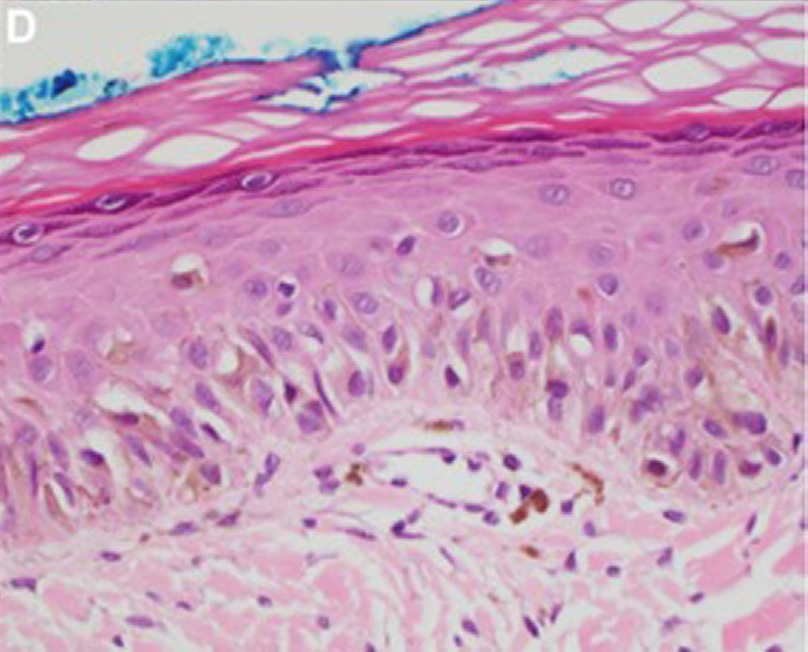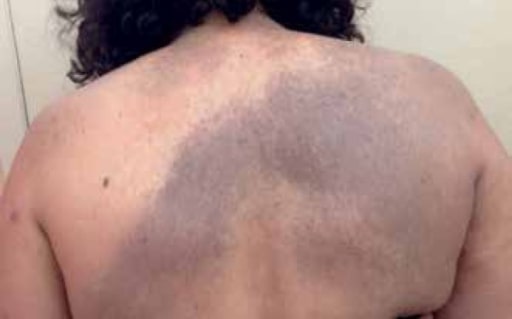Playlist
Show Playlist
Hide Playlist
Melanoma vs. Benign Melanocytic Nevus
-
Slides Dysplastic and Malignant Skin Lesions.pdf
-
Reference List Dermatology.pdf
-
Download Lecture Overview
00:01 So then, how do we distinguish between melanoma and a benign melanocytic nevus? Of course, a benign melanocytic nevus, commonly known as a mole is something that almost everybody has, some number of moles. 00:14 How do we tell the difference between that and a very severe aggressive skin cancer like melanoma? Well, there's this commonly used very simple acronym ABCD which is one way to think about the differences that we should look for in the particular features that would lead us towards melanoma. 00:32 In the top row here are pictures of melanoma of different types and the bottom row are benign melanocytic nevi. 00:40 They're called compound melanocytic nevi if they are exophytic again, growing off of the skin as opposed to a flat macule. 00:47 Looking at the first column there on the top, we have evidence of asymmetry. 00:52 This is a lesion which has a lot of asymmetry. 00:54 It's not the same on one side as it is on the other. 00:57 If you look at the lesion underneath it, that's a benign lesion and you can see it's pretty much symmetric from one side to the other. 01:04 The second one would be irregular borders and that second column certainly has dramatically irregular borders compared with the one underneath it which is almost a perfect circle. 01:16 The third one would be color variation and you can see in that third column you've got some reddish, then violaceous then brownish black kind of discoloration in that lesion compared with a homogenous uniform color in the mole underneath it Lastly, diameter, the size of a lesion and it's not just the size of the lesion at one point in time it's how much is that lesion growing over time. 01:38 If it's expanding rapidly over a matter of a few months you're going to be much more concerned about an aggressive melanoma. 01:48 There are actually four different subtypes of melanoma. 01:51 The most common of which, about 70% of cases is called superficial spreading melanoma and that's depicted here on the top left. 01:59 Importantly, superficial spreading melanoma as melanoma goes, it's the best one you could get. 02:04 Since it is fairly superficial, it can be readily removed. 02:08 It's the most treatable of all the different types of melanoma. 02:12 The second most common is called the nodular type. 02:15 The bad news of a nodular subtype of melanoma is that it is penetrating and growing deep or vertically rather than horizontally and so it tends to penetrate from the epidermis into the dermis more readily and you're more likely to have either local or distant metastasis. 02:32 The third type, less common, is lentigo maligna. 02:40 It starts off as a brownish discoloration of the skin and then can gradually evolve into more aggressive lesions. 02:46 It's common in the elderly, most commonly seen on the face and it is one of the lesser known subtypes of melanoma. 02:54 Lastly, acral lentiginous melanoma. 02:57 These ones are atypical because all the other ones are going to occur in sun-exposed areas but acral lentiginous melanoma tends to occur on the palms of the hands or the soles of the feet or even underneath the nail plates. 03:14 Looking at our patient’s image, again, very irregular borders we have the asymmetric features we have color that is very heterogenous in appearance. 03:23 This is very concerning for a malignant melanoma and she's definitely going to need a biopsy. 03:30 Let's look back at our case again and reflect on some of the features that may guide us towards melanoma or towards some other lesion. 03:37 We know that her age, as she gets older makes it more likely to have a malignant lesion. 03:43 That being said, superficial spreading melanoma is relatively common in younger men and women especially those who had significant sun exposure. 03:54 Sometimes, there's a preceding mole and the melanoma begins to grow within the mole. 03:59 But oftentimes, it may start de novo, so that's something to be mindful of. 04:03 Importantly, her lesion was itchy. 04:05 Now, you may not normally think of a skin cancer as itchy. 04:09 But if you do see evidence of itchiness or perhaps even pain that may suggest that there is dermal invasion and that the tumor has now gone beneath the epidermis into the dermis and now it's penetrating and involving some of the nerve endings embedded in the skin. 04:25 So, that may be a concerning finding. 04:28 Next up, our most common risk factors are the sun. 04:32 Folks who've had a history of severe sunburns as a child where there was blistering and a significant pain, that's a concern or just chronic sun exposure, folks who work outside in this case, our patient is an avid tennis player so she's getting a lot of sun exposure especially if she's not lathering up with sunscreen on a regular basis. 04:51 Of course, patients who are fair-complexioned are more susceptible. 04:54 Skin cancers in general are relatively rare amongst dark-skinned patients. 05:00 Their dark skin, their hyperpigmentation, is protective. 05:05 Then again, we've got the ABCD picture here. 05:08 As I mentioned, the asymmetry of the lesion the borders that are irregular, the color changing, and the diameter. 05:14 This is a four centimeter hyperpigmented macule. 05:17 That's going to steer you towards thinking about melanoma. 05:22 In terms of prognosis and management, a tumor that's confined to the skin you're just going to basically use surgical excision and looking for clean margins. 05:32 This is an approach called Mohs surgery named after a guy named Frederick Mohs in the 1930s. 05:38 Essentially, it's where the surgeon excises a very small sliver of skin and then sends that skin to the lab. 05:46 It's reviewed under microscopy while the patient is waiting and you continue to take off little slivers of skin until you're sure you have clear, clean margins. 05:55 Once you've got clean margins then you can basically close the case and move on. 06:02 The likelihood of having lymph nodes that are involved is entirely dependent upon how deep that initial lesion is. 06:10 You're almost always going to assess the most proximal lymph nodes to see if there's any evidence of tumor involvement there. 06:16 That's going to help with staging. 06:18 The presence of distal metastasis correlates with initial depth of lesion. 06:23 Once you've got that tumor penetrating into the dermis you're very likely to have issues with proximal nodes involved or even metastasis somewhere else in the body. 06:33 The staging system that is commonly used uses Clark's Levels. 06:37 These are basically a grading system that looks at the depth of lesion and predicts five-year mortality. 06:46 Along the same lines, like many cancers they use the TNM staging criteria, which is the size of the tumor is there proximal lymph node involvement and then is there any evidence of metastasis. 06:59 In general, melanoma is a very aggressive skin cancer. 07:03 Patients who have stage four melanoma it's almost a universally fatal diagnosis. 07:10 So very tragic when diagnosed at that stage. 07:13 There is also a high rate of relapse even for those who did have a good clean margin from a superficial spreading tumor. 07:19 You really have to be very vigilant about following these patients over time.
About the Lecture
The lecture Melanoma vs. Benign Melanocytic Nevus by Stephen Holt, MD, MS is from the course Neoplasms of the Skin.
Included Quiz Questions
Which of the following is a feature of benign melanocytic nevi?
- Homogenous color
- Irregular borders
- Evolving shape
- Diameter > 1 cm
- Asymmetrical shape
Which of the following statements is true regarding melanoma?
- Nodular melanoma has a strong tendency for widespread dissemination and metastasis.
- Acral lentiginous melanoma typically arises in sun-exposed areas of the skin.
- Lentigo maligna is commonly seen on the face and has the best prognosis.
- Most superficial spreading melanomas have already metastasized at the time of diagnosis.
Which of the following statements is correct?
- Moles that are itchy or painful may indicate dermal invasion.
- Nodular melanoma is relatively common in younger individuals.
- Almost all melanomas arise from preexisting benign nevi.
- Fair complexion is protective against melanoma.
Which of the following statements is true regarding the prognosis of melanoma?
- The probability of metastasis is most strongly predicted by measuring the thickness of the tumor.
- Melanoma is very responsive to chemotherapy and radiotherapy.
- Melanoma is a slow-growing tumor with a low relapse rate.
- TNM staging criteria are not used because malignant cells rarely spread to the lymph nodes.
Customer reviews
4,5 of 5 stars
| 5 Stars |
|
1 |
| 4 Stars |
|
1 |
| 3 Stars |
|
0 |
| 2 Stars |
|
0 |
| 1 Star |
|
0 |
Very well prepared lections. The explanations are clean and nice without theatrical exaggerations.
ME GUSTÓ COMO EXPLICA EL TEMA, SIN EMBARGO ME HUBIERA AYUDADO SI AGREGARA MAS INFO Y DETALLES SOBRE ESTE TEMA , COMO FISIOPATOLOGIA .






